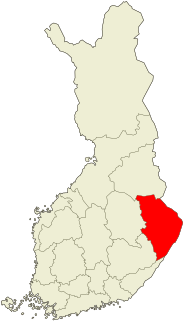Related Research Articles

Lake Ladoga is a freshwater lake located in the Republic of Karelia and Leningrad Oblast in northwestern Russia, in the vicinity of Saint Petersburg.

The Republic of Karelia is a federal subject of Russia, located in the northwest of Russia. Its capital is the city of Petrozavodsk. Its population in 2010 was 643,548.

Joensuu is a city and municipality in North Karelia. It was founded in 1848. The population of Joensuu is 76,543, and the economic region of Joensuu has a population of 115,000. As is typical of cities in Eastern Finland, Joensuu is monolingually Finnish.

North Karelia is a region in eastern Finland. It borders the regions of Kainuu, North Savo, South Savo and South Karelia, as well as Russia.

South Karelia is a region of Finland. It borders the regions of Kymenlaakso, South Savo and North Karelia, as well as Russia.

Karelia, the land of the Karelian people, is an area in Northern Europe of historical significance for Finland, Russia, and Sweden. It is currently divided among the northwestern Russian Federation and Finland.

Sparrow Lake is a lake in the Great Lakes Basin in Central Ontario, Canada. It is situated north-west of the town of Orillia and south of the town of Gravenhurst, Ontario and approximately 150 kilometres and a 1.5 hour drive north of the Greater Toronto Area. Sparrow Lake is the most southerly lake in the popular Muskoka tourist region.
Below is a list of Finnish language exonyms for places in non-Finnish-speaking areas:

The lakes of Titan, Saturn's largest moon, are bodies of liquid ethane and methane that have been detected by the Cassini–Huygens space probe, and had been suspected long before. The large ones are known as maria (seas) and the small ones as lacūs (lakes).

Ligeia Mare is a lake in the north polar region of Titan, the planet Saturn's largest moon. It is the second largest body of liquid on the surface of Titan, after Kraken Mare. Larger than Lake Superior on Earth, it is mostly composed of liquid methane, with unknown but lesser components of dissolved nitrogen and ethane, as well as other organic compounds. It is located at 78° N, 249° W, and has been fully imaged by the Cassini spacecraft. Measuring roughly 420 km (260 mi) by 350 km (217 mi) across, it has a surface area of about 126,000 km2, and a shoreline over 2000 km (1240 mi) in length. The lake may be hydrologically connected to the larger Kraken Mare. Its namesake is Ligeia, one of the sirens in Greek mythology.

Koitajoki is a river in Eastern Finland and partly in Russia in Northern Europe. Having its origin just by the international boundary in Ilomantsi of Northern Karelia in Finland, the Koitajoki River enters the territory of the Republic of Karelia in Russia, to return to Finland some 30 kilometres (19 mi) further south. It then flows northwest through the Petkeljärvi National Park and the Kesonsuo bog area, and further downstream receives the outflow from Lake Koitere. The main part of the waters are then directed through a tunnel of the 84-megawatt Pamilo hydroelectric power plant, which bypasses some 20 kilometres (12 mi) of the natural course of the lowest part of the river.
Lake Tikshozero is a freshwater lake, located in Loukhsky District of the Republic of Karelia and in Kandalakshsky District of Murmansk Oblast in Russia. It is one of the biggest lakes in Karelia. The area of the lake is 209 square kilometres (81 sq mi), and the area of its basin is 1,080 square kilometres (420 sq mi). The outflow of the lake of the Lopskaya River, which flows north as two separate streams into Lake Kovdozero and belongs to the drainage basin of the Kovda River and of the White Sea.

Bolsena Lacus is one of a number of hydrocarbon lakes found on Saturn's largest moon, Titan.

Neagh Lacus is one of a number of hydrocarbon lakes found on Saturn's largest moon, Titan. The lake is composed of liquid methane and ethane, and was detected by the Cassini space probe.

Sotonera Lacus is one of a number of hydrocarbon lakes found on Saturn's largest moon, Titan.

Feia Lacus is one of a number of hydrocarbon seas and lakes found on Saturn's largest moon, Titan. It was named in 2007 on the basis of data taken by the space probe Cassini.

Koitere Lacus is one of a number of hydrocarbon lakes found on Saturn's largest moon, Titan. The lake is composed of liquid methane and ethane, and was detected by the space probe Cassini.

Müggel Lacus is one of a number of hydrocarbon seas and lakes found on Saturn's largest moon, Titan.

Ladoga Lacus is a geographical feature on Saturn's largest moon, Titan, named after Lake Ladoga, Russia. It is one of a number of "methane lakes" found in Titan's north polar region.
References
- 1 2 3 "Koitere (04.941.1.001)". Järviwiki. Finnish Environment Institute . Retrieved 22 Feb 2014.(in English)
- ↑ Coustenis, A.; Taylor, F. W. (21 July 2008). Titan: Exploring an Earthlike World. World Scientific. pp. 154–155. ISBN 978-981-281-161-5.
| This Eastern Finland location article is a stub. You can help Wikipedia by expanding it. |